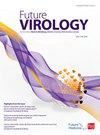迷迭香酸抑制裂谷热病毒:体外、计算和分析研究
IF 1.4
4区 医学
Q3 VIROLOGY
引用次数: 0
摘要
目的:研究迷迭香酸(RA)对裂谷热(RVF)病毒的抗病毒潜力。方法:通过评估病毒感染率的降低来研究其抗病毒活性:通过评估病毒感染滴度的降低情况来研究其抗病毒活性。为研究其作用机制,进行了计算和 LC-MS 研究。具体方法是测试 RA 及其主要代谢物与关键感染性蛋白之间的相互作用,并确定 RA 的细胞渗透性。结果在感染后使用 RA,RVF 感染性滴度明显降低(45.5%),而在感染前使用 RA,感染性滴度降低 17.7%。记录的数据表明,RA 及其代谢物对 RVFV 的帽结合蛋白和糖蛋白 C 有抑制潜能,而这两种蛋白是病毒转录不可或缺的成分。液相色谱-质谱(LC-MS)显示,细胞中含有 RA,支持其在细胞内与病毒相互作用。结论这些抗病毒潜力可能为未来开发抗 RVF 药物奠定了良好基础。本文章由计算机程序翻译,如有差异,请以英文原文为准。
Rosmarinic acid inhibits Rift Valley fever virus: in vitro, computational and analytical studies
Aim: The antiviral potentials of rosmarinic acid (RA) against Rift Valley fever (RVF) virus were investigated. Methods: Antiviral activity was investigated by evaluating the reduction in the viral infectivity titer. Computational and LC–MS studies were performed for investigating the mechanism of action. This is via testing the interaction between RA and its major metabolite with the key infectivity proteins and determination of RA cellular permeability. Results: A superior reduction in RVF infectivity titer (45.5%) was observed when RA was applied post-infection compared to 17.7% reduction following its application before infection in addition to time-dependent inactivation kinetics. Recorded data showed in-silico inhibitory potential of RA and its metabolite against RVFV cap-binding protein and glycoprotein C, which are integral for viral transcription. LC–MS revealed cellular inclusion of RA, supporting its intracellular viral interaction. Conclusion: These antiviral potentials might suggest a promising foundation for future anti-RVF drug development.
求助全文
通过发布文献求助,成功后即可免费获取论文全文。
去求助
来源期刊

Future Virology
医学-病毒学
CiteScore
4.00
自引率
3.20%
发文量
84
审稿时长
6-12 weeks
期刊介绍:
Future Virology is a peer-reviewed journal that delivers essential information in concise, at-a-glance article formats. Key advances in the field are reported and analyzed by international experts, providing an authoritative but accessible forum for this ever-expanding area of research. It is an interdisciplinary forum for all scientists working in the field today.
 求助内容:
求助内容: 应助结果提醒方式:
应助结果提醒方式:


